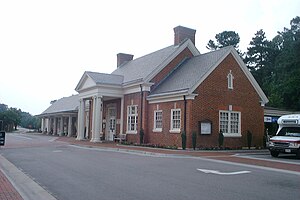Williamsburg (Amtrak station)
|
Williamsburg
|
|||||||||||
|---|---|---|---|---|---|---|---|---|---|---|---|

The station building.
|
|||||||||||
| Location | 468 North Boundary Street Williamsburg, Virginia |
||||||||||
| Coordinates | 37°16′32″N 76°42′28″W / 37.27556°N 76.70778°WCoordinates: 37°16′32″N 76°42′28″W / 37.27556°N 76.70778°W | ||||||||||
| Line(s) | |||||||||||
| Platforms | 1 side platform | ||||||||||
| Tracks | 1 | ||||||||||
| Connections | |||||||||||
| Construction | |||||||||||
| Parking | Yes; free | ||||||||||
| Disabled access | Yes | ||||||||||
| Other information | |||||||||||
| Station code | WBG | ||||||||||
| History | |||||||||||
| Opened | 1935 | ||||||||||
| Traffic | |||||||||||
| Passengers (FY2015) | 61,625 annually |
||||||||||
| Services | |||||||||||
|
|||||||||||
Williamsburg Transportation Center is an intermodal transit station in Williamsburg, Virginia. Operated by Williamsburg Area Transit Authority, it is the central hub for local buses and also serves Amtrak's Northeast Regional train as well as Greyhound Lines and Hampton Roads Transit intercity buses.
The area has both a central intermodal transportation center and an extensive public transit bus system prepared to serve local users and visitors. The center is located in a restored building which was formerly a Chesapeake and Ohio Railway (C&O) passenger station near the Historic Area, the College of William & Mary, and the downtown area. It affords easy access to the Colonial Williamsburg Visitor's Center and virtually all types of passenger ground transportation services are located there.
Originally known as Middle Plantation, Williamsburg's site had been selected in 1632 for the very reason that it was on the center ridge, or spine, of the land between the adjacent James and York rivers. After the capital of Virginia had moved to Richmond in 1780 under the leadership of Governor Thomas Jefferson during the American Revolutionary War, Williamsburg had been reduced in prominence. It was not sited on a major water route and in the 18th and early 19th century, transportation in Virginia was largely by navigable rivers and in some cases, canals. Although new railroads seem to be springing up in many places after 1830, until long after the American Civil War (1861–1865), none had come to Williamsburg or the lower Peninsula.
...
Wikipedia
